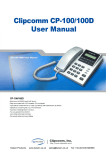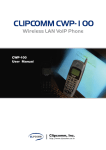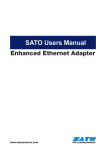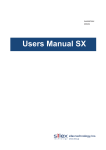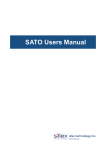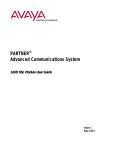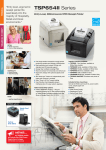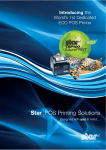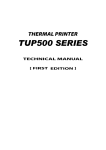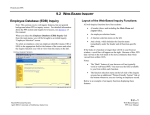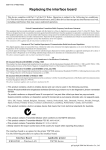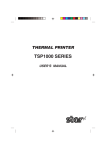Download Star Micronics IFBD-HW03/04 Network Card User Manual
Transcript
Product Specifications Manual WiFi Ethernet I/F Card IFBD-HW03/04 Rev. No. 0.00 Star Micronics Co., Ltd. Special Products Operating Division 1. Read First ....................................................................................................................................................... 1-1 1.1. 2. 3. Main Settings at Product Shipment ........................................................................................................ 1-1 1.1.1. Wireless LAN Unit Default Settings .......................................................................................... 1-1 1.1.2. TCP/IP Default Settings.............................................................................................................. 1-1 1.1.3. Operator Permission Log-in Password Default Settings ....................................................... 1-1 1.1.4. Setting the IP Addresses ............................................................................................................ 1-1 Hardware ........................................................................................................................................................ 2-1 2.1. Supporting Destination for Wireless Units............................................................................................. 2-1 2.2. Sub-chassis (Brackets Mounted to Printer) ............................................................................................ 2-1 2.3. Specifications ......................................................................................................................................... 2-2 2.4. Environment Conditions......................................................................................................................... 2-3 2.5. Ratings.................................................................................................................................................... 2-3 Mechanical Specifications.............................................................................................................................. 3-1 3.1. General Description................................................................................................................................ 3-1 3.2. Features .................................................................................................................................................. 3-1 3.3. Protocols................................................................................................................................................. 3-2 3.3.1. Setting the IP Addresses ............................................................................................................ 3-3 3.3.1.1. DHCP/BOOTP...................................................................................................................... 3-4 3.3.1.2. RARP..................................................................................................................................... 3-4 3.3.1.3. ARP........................................................................................................................................ 3-5 3.3.2. LPD Specifications....................................................................................................................... 3-6 3.3.3. Raw Mode Print (TCP #9100) Specifications .......................................................................... 3-7 3.3.4. TELNET Specifications ............................................................................................................... 3-8 3.3.5. HTTP Specification ...................................................................................................................... 3-9 3.3.6. FTP Specification....................................................................................................................... 3-10 3.3.6.1. Printing Mechanism Using FTP ....................................................................................... 3-12 3.3.6.2. Setting Mechanism Using FTP ........................................................................................ 3-12 3.3.6.3. Updating Firmware Using FTP ........................................................................................ 3-14 3.3.6.4. Example of the Procedures for Updating the Firmware of the Product Using FTP . 3-14 3.3.7. DNS Specification ...................................................................................................................... 3-17 3.3.8. IPP ............................................................................................................................................... 3-17 3.3.8.1. IPP Job Detail Specifications ........................................................................................... 3-17 3.3.8.2. IPP Attribute Detail Specifications ................................................................................... 3-17 3.3.8.3. Secure Communications (SSL) Printing Function Specifications............................... 3-18 3.3.9. POP3 Specifications.................................................................................................................. 3-19 3.3.9.1. Print Specifications ............................................................................................................ 3-19 3.3.9.2. Restrictions ......................................................................................................................... 3-19 3.3.9.3. 3.3.10. Filter Definition Character String ..................................................................................... 3-19 SMTP Specification ................................................................................................................... 3-20 3.3.10.1. 3.3.11. 3.4. Transmission Message Format ....................................................................................... 3-20 Universal Setting Function ....................................................................................................... 3-22 UDP/IP Specifications.......................................................................................................................... 3-23 3.4.1. JCP (Silex-technology’s setting protocol (UDP #19541) ..................................................... 3-23 3.4.2. SNMP Specification................................................................................................................... 3-24 3.5. 3.4.2.1. Support MIB........................................................................................................................ 3-24 3.4.2.2. TRAP Occurrence Phenomenon..................................................................................... 3-31 Other Specifications ............................................................................................................................. 3-32 3.5.1. DIP Switches and LED Specifications .................................................................................... 3-32 3.5.2. Flash ROM Specifications ........................................................................................................ 3-32 3.5.3. Self-Diagnosis Function Specifications .................................................................................. 3-33 3.6. Settings/Display Items.......................................................................................................................... 3-35 3.6.1. General Settings ........................................................................................................................ 3-35 3.6.2. Wireless Settings ....................................................................................................................... 3-35 3.6.3. TCP/IP Settings.......................................................................................................................... 3-35 3.6.4. POP3 (Email Reception) Settings ........................................................................................... 3-36 3.6.4.1. Basic Settings..................................................................................................................... 3-36 3.6.4.2. Account Settings For Each User (User Profile 1 to 4).................................................. 3-36 3.6.5. SMTP (Email Sending) Settings .............................................................................................. 3-36 3.6.5.1. Basic Settings..................................................................................................................... 3-36 3.6.5.2. Event to Address Settings ................................................................................................ 3-36 3.6.6. SNMP Settings........................................................................................................................... 3-37 3.6.7. Secure Print Settings ................................................................................................................ 3-37 3.6.8. RAS Counter Settings............................................................................................................... 3-37 3.6.9. Memory Switch Settings ........................................................................................................... 3-37 3.6.10. SSL Identification Creation Settings (Web Only) .................................................................. 3-37 3.7. 3.6.10.1. Identification Information Settings ................................................................................... 3-37 3.6.10.2. Time Limit Settings ............................................................................................................ 3-37 Status Display....................................................................................................................................... 3-38 3.7.1. Printer Status Display................................................................................................................ 3-38 3.7.2. System Status Display .............................................................................................................. 3-39 IFBD-HW03/04 Product Specifications Rev. 0.00 1. Read First This product is a printer server (I/F card) dedicated to STAR POS printers that conform to wireless LAN IEEE802.11b. At the time that this specifications manual was created, the following STAR POS printer was targeted. TSP743 F/W V6.0 or later TSP743 will not support this printer driver simply by updating the F/W. Only printers whose F/W at the time of default shipment is V6.0 or later can be used. 1.1. Main Settings at Product Shipment The wireless LAN unit and TCP/IP settings which are necessary to use this product are outlined below. Refer to section “3.6 Setting Display Items” below for details on settings that are not listed here. 1.1.1. Wireless LAN Unit Default Settings Wireless Mode AdHoc (Communication not using an access point) SSID Channel “STAR-WIFI” 11 Web Encryption Disabled WEP Key * No setting Set the PC to the above settings when using this product. Once the PC and product are connected, it is possible to change the settings of this product to those that support the environment of use, by using a Web browser. 1.1.2. TCP/IP Default Settings RARP client Enabled DHCP/BOOTP client Enabled IP address “0.0.0.0” Subnet mask “0.0.0.0” Default gateway “0.0.0.0” DNS Primary Server “0.0.0.0” DNS Secondary Server “0.0.0.0” 1.1.3. Operator Permission Log-in Password Default Settings To change settings on this product, use WEB, TELNET and FTP protocols. However, when doing so, it is necessary to log-in to this product with an account having operator permission. Account information is shown below. Operator account name: “root” Password “” Nothing needs to be input. It is possible to change the password after logging in. 1.1.4. Setting the IP Addresses It is possible to set the IP address for this product using one of four types of methods. They are RARP, DHCP, ARP or fixed flash memory. When a procedure for setting a multiple of IP address according to the network environment is effective, the methods above are arranged in order of priority. For that reason, when using with a fixed IP address written to the flash memory, it is recommended that it be used after disabling the product’s RARP, and DHCP/BOOTP settings. 1-1 IFBD-HW03/04 Product Specifications Rev. 0.00 2. Hardware 2.1. Supporting Destination for Wireless Units The wireless frequency bandwidth that can be used with a 2.4 GHz frequency bandwidth used in IEEE802.11b varies according to the individual regulations of each country. This difference is supported by having three types of PCB units for each area of use. The wireless communication channels that can be used with the IEEE802.11b on each PCB for each country are outlined below. Also, to identify the destination of the product, a two-digit alphabetical symbol that indicates where the product is to be used, is inscribed on the Ethernet-MAC address tool. Country 2.2. Communication Channel Identification Marks IEEE802.11b Ethernet-MAC Address Tool North America 1 to 11 US Europe 1 to 13 EU Japan 1 to 14 JP on Sub-chassis (Brackets Mounted to Printer) In order for this product to be used with a multiple of POS printer models, there are two types of bracket shapes mounted to the printer. The following shows the product name for each shape of bracket. Applicable Printers Product Name and Model Name TSP700 Series IFBD-HW03 2-1 IFBD-HW03/04 Product Specifications Rev. 0.00 2.3. Specifications Network I/F Unit: LED: Setting Switches: Conforms to IEEE802.11b CF Card Type I and II LINK x 1 (green) DIP-SW 2bit PCB Dimensions (Target): 69 mm x 95 mm (Tolerance: ±0.5 mm) t = 1.6 mm (Tolerance: ±0.2 mm) Power Supply: Operating Voltage: 5 V ±5% Rated Consumption Current: 500 mA Max MTBF Value: 90,000 hours 2-2 IFBD-HW03/04 Product Specifications Rev. 0.00 2.4. Environment Conditions The following outlines the environmental conditions. 2.5. Ambient Storage Conditions Storage Temperature: -20°C to +70°C Storage Humidity: 20% to 90% (No condensation) Ambient Operating Conditions Operating Temperature: 0°C to +55°C Operating Humidity: 20% to 80% (No condensation) Ratings EMI FCC Part15 Class A VCCI Class A EN55022 Class B 2-3 IFBD-HW03/04 Product Specifications Rev. 0.00 3. Mechanical Specifications 3.1. General Description This product is a wireless network interface card (printer server) embedded in the Star's POS printer. The wireless unit conforms to IEEE802.11b specifications. 3.2. • Features Supports the following Star Micronics POS printer. Supports: TSP743 • To supply power from the printer to the adapter, it is not necessary to connect the separate AC adapter for this adapter. • Incorporated with SSL (Secure Sockets Layer) for printing in secure communications (SSL). Decrypts encrypted print data and outputs to the printer therefore predate that is protected from eavesdropping on the network and from falsification. • Supports #900 on TCP/IP and print protocols of LPR and IPP. Also, FTP (supporting binary data) printing is possible. For that reason, it can be used on many PC operating systems. Supports Windows98/ME/NT4/2000/XP, LINUX, MAC-OS-X • Sends the printer's ASB status to be read on the PC. • A multiple protocols to be used simultaneously. • Supports multi-session printing. • Receives e-mail (POP3 protocols) and outputs them to the printer for printing. (Only supports text data) • Emails automatically according to status changes, such as printer errors. • Uses flash memory. This enables updating firmware via the network. • Allows monitoring of changes in settings and statuses of the product and printer via each dedicated setting utility, TELNET, HTTP and FTP. 3-1 IFBD-HW03/04 Product Specifications Rev. 0.00 3.3. Protocols TCP/IP Network Layers ARP, RARP, IP, ICMP Transport Layers TCP, UDP Application Layers BOOTP, DHCP, DNS LDP, IPP, (Printing Functions) Raw Mode Print (TCP #9100: Print/Get Print Status) POP 3, (Text Printing Functions) SMTP (Supports status notification to 3 locations) HTTP (Supports English, Japanese printer detail status tables) FTP (Gets printer status, settings, Printing, F/W updates) TELNET (Gets printer status, settings) UDP/IP Application Layers JCP (Silex-technology’s setting protocol (UDP #19541) SNMP Others Embedded with MIB-2, HostResource-MIB, Silex-technology Corporation PrivateMIB Self-diagnosis printing and setting printing Easy upgrades using flash memory 3-2 IFBD-HW03/04 Product Specifications Rev. 0.00 TCP/IP Specifications This product has the following TCP/IP specifications. • IP version 4 • IP routing: 1 • ICMP Redirect Request • ICMP Echo Request • UDP Maximum Number of Sessions: 8 • UDP Maximum Data Gram Length: 2048 octet for both sending and receiveing • UDP Omitted When Sending Check Sum (Normally 0) • TCP Maximum Number of Sessions: 24 (Of these, 1 is used in LISTEN) • TCP Window Size: Maximum 8192 octet for both sending and receiving (Variable using upper protocols) The TCP/IP protocol environment is provided with LPD, IPP, Raw Mode Print (TCP #9100) and FTP for printing, and can use TELNET, HTTP and FTP to change each setting. Supports TCP/IP printing which is provided as standard with Windows NT/Windows 2000/Windows XP. Specifications of protocols differ with the normal UNIX for these LPD, so printing is not possible by spooling to a UNIX server once, such by sending Windows to UNIX to product. Also, because LPD is not provided in Windows 95, Windows 98 or Windows ME, direct printing is not possible. However, direct printing is possible by using a tool dedicated to that purpose (Star LPR). 3.3.1. Setting the IP Addresses This product has five IP address setting methods for Star’s independent setting protocols. They are DHCP; BOOTP; RARP; and ARP. Immediately after initializing settings, all settings methods are initialized and enabled. Therefore, it is possible to set IP addresses using any method. The following describes how to set IP addresses using each method, assuming the following addresses: MAC address: 00:80:92:12:34:56; IP address: 192.168.1.1 (pbox) * The IP address dynamically ensured by this product is not written to the storage field of the setting information. Specifically, if setting an IP address using either DHCP, BOOTP, RARP or ARP and starting up that IP address the next time, it is necessary to change the IP address of the setting information region using http (WEB), FTP and TELNET. 3-3 IFBD-HW03/04 Product Specifications Rev. 0.00 3.3.1.1. DHCP/BOOTP This product conforms to RFC2131/RFC2132. It is possible to get the IP address, sub-net mask, gateway address and DNS server address using either the DHCP server or the BOOTP server. A work station running either a DHCP server or BOOTP server is necessary for setting IP addresses using DHCP/BOOTP. • Supports Windows NT DHCP server specifications (specifications incorporating Microsoft expansion). • Because part of the DHCP Discover protocol is compatible with the BOOTP Request, both are handled as the same thing. For example, if a BOOTP Reply is returned for a DHCP Discover, the system uses the address obtained by BOOTP. • The DHCP/BOOTP Request constantly sends with a broadcast (255.255.255.255). However, only the DHCP Renew Request (delay request for address use time) is sent to the server that obtained that address. • DHCP/BOOTP timeout is 4 seconds, which is the recommended value for RFC2131. However, variable ±1 second according to a random number. There are three retries. • Use the set IP address in the issuer’s address and DHCP/BOOTP CIADDR (client IP address) field if the IP address is preset. When a normal response is received, it switches to the newly obtained IP address. • The issuer address and CIADDR become 0.0.0.0 if the IP address is not set. Also, in such a case, a “B” flag (0x8000) is set to the DHCP Discover packet flags field, and a request is made to the server for each ‘broadcast of DHCP Response.’ Setting Method: Register the IP addresses to be set and the combination of MAC addresses to the DHCP/BOOTP server, then turn on the power to the product. 3.3.1.2. RARP A work station running either an RARP server is necessary for setting IP addresses using RARP. Setting Method: Register the IP addresses to be set and the combination of MAC addresses to the RARP server, then turn on the power to the product. 3-4 IFBD-HW03/04 Product Specifications Rev. 0.00 3.3.1.3. ARP To set an IP address using ARP, register the IP address in combination with the MAC address and then transmit a ping. Setting Example: (1) Turn on the power to the product (2) Register the IP address in combination with the MAC address to the ARP table. (For UNIX) arp -s pbox 00:80:92:12:34:56 temp arp –a (For Windows) arp -s pbox 00:80:92:12:34:56 arp –a (3) Transmit a ping. ping pbox 3-5 IFBD-HW03/04 Product Specifications Rev. 0.00 3.3.2. LPD Specifications This products LPD protocol conforms to RFC1179. The list of logic printer names is handled as a queue name. The product waits for the queue name Ip. Example: Setting example for printcap pboxlp:¥ :lp=:rm=pbox:rp=lp: When sending jobs using Ipr, the order of sending data files and control files inside the jobs does not affect the printing operation. Deleting jobs using Iprm is not supported, but as a dummy response, ACK (0x0A of one octet) is returned. The Ipq response value format is UNIX compatible, but the long format using Ipq-I is an independent format including the printer status. Example: Ipq short format printer ready lpq –Ppboxlp no entries Example: Ipq short format printer not ready lpq –Ppboxlp Warning: Printer not ready ←This message is applied regardless of the reason. no entries Example: Ipq long format printer ready lpq -l –Ppboxlp Ready no entries Example: Ipq long format printer not ready lpq -l –Ppboxlp Not Ready Printer Cover Open Receipt Paper End no entries 3-6 IFBD-HW03/04 Product Specifications Rev. 0.00 3.3.3. Raw Mode Print (TCP #9100) Specifications This product provides Raw Mode Print communications that is used as a listen port for the Port: 9100, as a printing mechanism running under the TCP/IP environment. With Raw Mode Print, all data that flows between TCP sessions is considered data handled between the printer and PC. Bi-directional data transmission is thus performed. The Raw Mode Print function in this product operates under the following conditions. • The maximum number of sessions accepted on the Port: 9100 is settable using the following setting items. • 9100 Multi-session: Enable: 8; 9100 Multi-session: Disable: 1 A rejection of acceptance (TCP reset) is issued from the product to all PCs that could not establish connection if there is no request for connection of more than the maximum number of sessions accepted. • Data traveling from the printer in the direction of the PC is printer status (ASB status) information obtained via the serial RS-232C. • Only when there is a change in the status is status data from the printer obtained by an interruption from the printer and sent to the PC. • The end of 1 data is considered to be established at the cut off of a TCP session (TCP FIN, TCP RST • TCP Session Timeout). Special communication procedures are not performed on the printer at this time. In the event that special control is necessary, such as stopping the printer, that is performed on the PC. 3-7 IFBD-HW03/04 Product Specifications Rev. 0.00 3.3.4. TELNET Specifications The TELNET of this product conforms to RFC854. It employs a conversational menu format and is used to change internal settings, reference and display the status. There are multiple accounts for logging in. It supports the user names and passwords outlined in the table below. The viewable and settable items vary for each account. (See section 2.3.4 Settings/Display Items for details on settings an parameters that can be referenced.) Account User Name Password Target Root User root Can be set System controllers • No differentiation between • Seven or more char. of ASCII upper • Initial Value: No characters and lower case characters • No differentiation between upper and lower case characters User (Any ASCII character string) None General users Example of Execution of TELNET Commands Star Micronics IFBD-HW03/04 Ver 1.0.0 TELNET server. Ethernet Address [ 00:80:92:12:34:56 ] Copyright (C) 2004 STAR MICRONICS CO.,LTD. Copyright (C) 2004 silex technology, Inc. login: root 'root' user needs password to login. password: User 'root' logged in. No. Item Value (level.1) --------------------------------------------------------------------1 : Configure General 2 : Configure TCP/IP 3 : Configure SNMP 4 : Configure Printer 5 : Web Page Refresh Interval(sec.) : 10 96 : Display Status 97 : Reset Settings to Defaults 98 : Restart Print Server 99 : Exit Please select(1 - 99)? 1 No. Item Value (level.2) --------------------------------------------------------------------1 : Change root Password : “” 2 : NIC Reset Control : DISABLE 99 : Back to prior menu Please select(1 - 99)? 3-8 IFBD-HW03/04 Product Specifications Rev. 0.00 3.3.5. HTTP Specification This product supports HTTP. This means that it is possible to use a Web browser to change the NIC and printer settings, display system information when running the product, and view that status of the printer port. • Conforms to HTTP 1.0 (RFC 1945) • Conforms to HTML 3.0. • Writing is password protected to prevent access by anyone other than the root and maker. • The printer port status display is automatically updated each time it is set by Web or TELNET (1 to 300 seconds; Initial value: 10 seconds). Also, when updated, it automatically moves to a position where it is easy to view the status display. Note: The display of each browser may vary slightly. There are multiple accounts for setting items necessary for logging in using a Web browser. It supports the user names and passwords outlined in the table below. The viewable and settable items vary for each account. Account User Name Password Target Root User root Can be set System controllers • No differentiation between • Seven or more char. of ASCII upper • Initial Value: No characters and lower case characters • No differentiation between upper and lower case characters User (Any ASCII character string) None General users 3-9 IFBD-HW03/04 Product Specifications Rev. 0.00 3.3.6. FTP Specification The FTP of this product conforms to RFC959. It is possible to specify ASCII (A), BINARY (I) or TENEX (L 8) as the transmission mode, but the differences in the modes is not handled by the product, and depends on the client side. There are multiple accounts for setting items necessary for logging in by the client. It supports the user names and passwords outlined in the table below. Account Root User User Name root • No differentiation between upper and lower case characters Password Can be set • Seven or more char. of ASCII • Initial Value: No characters • No differentiation between upper and lower case characters Target System controllers User (Any ASCII character string) None General users The following outlines the directory configuration. * The files in each directory are dummies. It is possible for the same actions by reading and writing with any filename, if in the same directory. / |─lp/ | print.dat | |─config/ | config.txt | |─flash/ fwdata.bin Port Name Manufacturer Permission Root User Permission lp Writable config Readable Writable flash User Permission Functions Writable Print port It is possible to print the contents of the file by uploading it to this directory. Setting function * See section 2.6.2 Setting Functions Using FTP Readable Firmware update port * See section 2.6.3 Updating Firmware Using FTP Writable 3-10 IFBD-HW03/04 Product Specifications Rev. 0.00 Specify whether to issue put after issuing the cd command and transferring to the transfer destination directory, or the transfer destination directory to the transfer destination filename of put. Example 1: Specifying the transfer destination directory name for output ftp>put testfile /lp 200 PORT command Ok. 150 Open data connection 226 Data connection closed 7801 byte sent in.... * Specify transfer destination when using put Example 2: Changing the current directory for output ftp>cd /lp 250 Command Ok. ftp>put testfile 200 PORT command Ok. 150 Open data connection 226 Data connection closed 7801 byte sent in.... * Use put after specifying the transfer destination using cd. The FTP NLST (ls) command and LIST (dir) command response formats are compatible with UNIX, considering supporting FTP clients using GUI. Ex.: ftp> dir / 200 PORT command Ok. 150 Open data connection. total 0 d-w--w--w- 1 nobody nobody 0 Jan 1 1970 lp dr--r--r-- 1 nobody nobody 0 Jan 1 1970 config dr--r--r-- 1 nobody nobody 0 Jan 1 1970 flash 226 Data connection closed. ftp: 190 bytes received in 0.17Seconds 1.11Kbytes/sec. It is not possible to check the status using NLST/LIST with this product. However, as a substitute means, it is possible to check the status using the STAT command. The printer status is returned by provided the directory name (printer name) as an argument. The status of the FTP server is returned if STAT is issued without applying an argument. However, the STAT command is not a standard FTP command. Normally, it is possible to issue a STAT by using the QUOTE command on command line type FTP clients. Example 1: (When Printer Status is Normal) ftp / > quote stat lp FTP directory status: Ready End of status. Example 2: (When Printer Cover is Open) ftp / > quote stat lp FTP directory status: Not Ready Printer Cover Open Receipt Paper End End of status. 3-11 IFBD-HW03/04 Product Specifications Rev. 0.00 3.3.6.1. Printing Mechanism Using FTP It is possible to print by logging in to this product using FTP, then writing the file to the root directory or to the “Ip” directory (port). 3.3.6.2. Setting Mechanism Using FTP It is possible to view settings by logging in to this product using FTP, then accessing the “config” directory (port) and reading the file. Also, settings are made by uploading settings files from the client. Setting File Example MAC addr: 00:80:92:12:34:56 *** USER *** Printer Status :anonymou :Ready Web Page Refresh Interval(sec.) :10 << Configure General >> Change root Password :" ***** " NIC Reset Control :ENABLE << Configure WiFi - .11b >> Wireless Mode :Infra. SSID :"STAR-WIFI" Channel :11 Use WEP :None WEP Key :"" << Configure TCP/IP >> DHCP/BOOTP :ENABLE RARP :ENABLE IP Address :0.0.0.0 Subnet Mask :0.0.0.0 Default Gateway :0.0.0.0 Universal PnP :DISABLE 9100 Multi Session :ENABLE << Configure TCP/IP - DNS >> Primary Server :0.0.0.0 Secondary Server :0.0.0.0 << Configure TCP/IP - POP >> POP Protocol :DISABLE Check Interval(min.) :15 Local Time Zone :"+09:00" << Memory Switch Setting >> Code Page :Codepage 858 (Multilingual) Black Mark Sensor :Disable Shows the MAC address. The setting is rejected if the MAC address does not match this product when writing settings. Shows the user name currently accessing. Shows the current printer status. The password item is masked by * in the display. The password will be erroneous if re-written while masked with *, so settings are not possible if all characters are *. • Setting file format: “Item name;” “Setting” or “Item Name” = “Setting” • Item names and settings are separated by a colon (:) or an equal sign (=) in single byte characters. • A space or a tab code applied to the head or tail of an item name is ignored. • In the following cases, it is ignored and the next line is read. • The head character of the item name is any other than a number or an alphabetic character. • If a value that cannot be set is input, the status prior to that change in setting is returned and the connection is closed. When quit normally, the product will self-reboot. 3-12 IFBD-HW03/04 Product Specifications Rev. 0.00 Example: When a Setting Fails “451 Aborted; Data write error” is returned. ftp> cd config ftp> put config.txt 200 PORT command Ok. 150 Open data connection. 451 Aborted; Data write error. Example: When Ended Normally “226 Data connection closed.” is returned. Self-reboot ftp> cd config ftp> put config.txt 200 PORT command Ok. 150 Open data connection. 226 Data connection closed. 3-13 IFBD-HW03/04 Product Specifications Rev. 0.00 3.3.6.3. Updating Firmware Using FTP This uploads binary data for upgrades in bin format to the “flash” directory (port) with a binary mode by logging in to the product using FTP. • The firmware cannot be updated using FTP when starting up in the flash memory load mode when the power is turned on, by setting the DIP switches. • The “flash" port is viewable by all users. • Firmware update is only possible by logging in with the root or maker user. • When uploading or after it is completed, this checks whether transmission was correct by calculating the sum value of the firmware data on the FTP side. If transmission was not normal on the firmware, the update of the firmware is cancelled. • When the update is normally on FTP, the product will self-reboot. 3.3.6.4. Example of the Procedures for Updating the Firmware of the Product Using FTP The following describes an example of the procedures for F/W update of the product using FTP. // PC side environment // - OS: Windows 2000 or XP - File storage location: "C:¥IFBD-HW_FW_1.0.2" IFBD-HW03/04 F/W binary data "IFBD-HW03_04.bin" is in the folder. - FTP client software Startup the standard Windows FTP command from the command prompt. // IFBD-HW03/04 side environment // - TCP/IP address: 192.168.222.21 - Root permission password: “” * A password is unnecessary for default settings. 3-14 IFBD-HW03/04 Product Specifications Rev. 0.00 Startup the command prompt on the targeted PC in the environment outlined above. In that procedure, operate according to the following steps. Command Prompt Dump Explanation C:¥IFBD-HW_FW_1.0.2>dir IFBD-HW03/04 F/W binary file location confirmation There is no volume label for the C drive. The volume serial number is 387D-6F02. Directory of C:¥IFBD-HW_FW_1.0.2 2004/12/24 18:13 <DIR> . 2004/12/24 18:13 <DIR> .. 2004/10/28 09:06 1 file: 887,845 IFBD-HW03_04.bin 887,845 bytes 2 directories: 15,553,077,248 bytes of available space C:¥IFBD-HW_FW_1.0.2>ftp Startup the standard Windows FTP command. ftp> open 192.168.222.21 Specify the IFBD-HW03/04 IP address Connected to 192.168.222.21. >> IFBD-HW internal FTP server startup message 220 Star Micronics IFBD-HW03/04 Ver 1.0.0b3 FTP server. User (192.168.222.21:(none)): root Log-in as “root” user 331 Password required. No password (In default) Password: 230 User Logged in. >> Log in successful ftp> ls Issues Is command for IFBD-HW internal folder 200 PORT command Ok. name check 150 Open data connection. lp config >> Check “flash” folder flash 226 Data connection closed. ftp: 19 bytes received in 0.13Seconds 0.15Kbytes/sec. Change target folder to “flash” ftp> cd flash 250 Command Ok. Change FTP transfer to binary mode ftp> binary 200 Type set to I. Transfer F/W binary file ftp> put IFBD-HW03_04.bin 200 PORT command Ok. 3-15 IFBD-HW03/04 Product Specifications Rev. 0.00 150 Open data connection. 226 Data connection closed. ftp: 887845 bytes sent in 13.49Seconds 65.82Kbytes/sec. >> Transfer complete message ftp> quit Quit FTP command C:¥IFBD-HW_FW_1.0.2> 3-16 IFBD-HW03/04 Product Specifications Rev. 0.00 3.3.7. DNS Specification This product inquires the domain name and host name to the DNS name server and resolves IP addresses. Also, it is possible to get IP addresses of the DNS name server using DHCP. 3.3.8. IPP This product supports IPP (Internet Print Protocol)1.0. • IPP/1.0 • Supports HTTP/1.1 chunked encoding • Port 80 or 631 are available for use • Charset supports only UTF-8 • Supports Print-Job, Validate-Job, Get-Printer-Attributes, Get-Jobs, Get-Job-Attribute operations • Maximum 8 jobs The IPP Printer-URI of this product can use either “/ipp” or “/ipp/lp.” For example, if the IP address was 192.168.1.1, the URL will be “http://192.168.1.1/ipp.” 3.3.8.1. IPP Job Detail Specifications As a response to Print-Job, Job-ID and Job-URI are generated. Job-ID is a request ID of the VPORT level and takes values from 1 to 65535. Job-URI applies a Job-ID with “?” for the Printer-URI. If the IP address is 192.168.1.1 and the request ID was 215 with Printer-URI=”/ipp,” the job URL will be “http://192.168.1.1/ipp?215.” This product does not have spooling functions. Therefore, there is basically no response of the Print-job until data reception is completed and printing ends. However, it is possible to abort jobs being printed by issuing Get-jobs while printing, getting a job list and then issuing Cancel-job. After printing, the job is placed in the Completed status. When the maximum number of jobs is exceeded, the oldest Completed jobs are deleted in order. 3.3.8.2. IPP Attribute Detail Specifications The entire character string of the device ID is returned to the printer-info, and the printer model name (“MDL” keyword information) is returned to the printer-make-and-model if it was possible to get the IEEE1284 device ID from the printer port. The sysName and sysLocation contents of SNMP for each of the printer-name and printer-location are returned. Document-format supports “application/octet-stream” and “text/plain.” Job-sheet (burner) supports “none,” and “standard.” 3-17 IFBD-HW03/04 Product Specifications Rev. 0.00 3.3.8.3. Secure Communications (SSL) Printing Function Specifications This product is incorporated with SSL (Secure Sockets Layer) for printing in secure communications (SSL). HTTP is mounted on the upper application of SSL to enable encrypted communications. Encrypted communication is used in sending and receiving IPP printing and settings information to the Web browser. This product includes software developed by the OpenSSL Project for use in the OpenSSL Toolkit. (http://www.openssl.org/) Basic Specifications Protocol: SSL v2/v3 TCP port number: 443 Public key algorithm: RSA (Key bit length: Fixed to 512 bits) Encryption method/Key length: DES-40 DES-64 3DES-192 Hash Method: MD5 Authentication: Server authentication ID: Identification using self-naming ID. Secure communication (SSL) printing functions are not enabled in the default settings at the time of shipping. Initially, create an ID from the product Web page. When SSL communications are started, server authentication is performed in a hand-shake method for identification. At that time, the exchange of information of the public key encryption necessary for the client and the encryption method are determined. The client uses this public key to encrypt print data, but only the print server that issued that ID can decrypt this data. It is possible to set an effective time period for these IDs so that printing is no longer possible after that period has expired. This can be used by applying a printer usage time limit. After the time limit has expired, it is possible to create a new ID again, and to print using this new ID. Because this is a print server ID, it does not restrict clients. There is no authentication function on the client side. Furthermore, the name of the ID is not one related to a third party authentication mechanism; rather it is one in the printer server. Specify the print port for secure communication (SSL) printing as follows. (Ex.) https://192.168.1.1/ipp/lp It is also possible to make secure communication (SSL) settings in addition to the secure communication (SSL) print function. That URL is shown below. (Ex.) https://192.168.1.1/ 3-18 IFBD-HW03/04 Product Specifications Rev. 0.00 3.3.9. POP3 Specifications It is possible to send and print email using the Internet standard POP3 protocol. Up to 4 mail accounts can be registered. Filtering is also possible for received mail using size, title, addressee and sender. 3.3.9.1. Print Specifications Only the size and filename of the attached file are printed. 3.3.9.2. Restrictions It is possible to target mail that exceeds a predetermined size from reception. Use the POP LIST command response to calculate size. Use the POP UIDL command to eliminate mail that has been read from the targeted process after the second time. It is possible to delete received or printed mail from the server. 3.3.9.3. Filter Definition Character String The filter is defined by a character string of a maximum of 78 characters. The S: character string; F: character string; T: character string; and C: character string; are defined by character strings connected by “&” and “|” Use the following sentence by connecting using “&” (AND conditions) or “|” (OR conditions) for the filter settings. Clas s S: F: T: C: Target for Inspection Subject From To CC Example of Use S:news & S:daily F:rt-users T:[email protected] C:user | T:use Prints mail whose subject is daily and news. Prints mail from rt-users. Prints mail to support. Prints mail that includes addressee or user in CC field. Ex.: "T:user1 | C:user1 & F:[email protected] & S:title" Mail is printed with user 1 in to: or cc:; from: is set to [email protected], and the characters string of the title in the subject. 3-19 IFBD-HW03/04 Product Specifications Rev. 0.00 3.3.10. SMTP Specification This product supports SMTP. It is provided a function for notifying the operating conditions and the status of connected printers via email. The main functions are outlined below. Configures notification messages according to the system (protocol operating conditions) status and printer status Three addresses (email addresses) and notification message levels for each address can be specified. Queue notification messages according to the message transmission interval settings and supports a function for batch transmissions. This avoids continuous message transmissions Individual messages can be added to the content of the message by using a signature setting 3.3.10.1. Transmission Message Format The message specifications for sending from this product are outlined below. Messages are in English text only. One line comprises 63 characters; messages that exceed that amount are automatically provided with a line break. No encoding is applied. See the following page for an example of the transmission format. 3-20 IFBD-HW03/04 Product Specifications Rev. 0.00 Continued from previous page Example Message Format 0 1 2 3 4 5 6 01234567890123456789012345678901234567890123456789012345678901234 +---------------+---------------+---------------+---------------+---------------+---------------+-----From: Star Micronics To: [email protected], [email protected] Subject: Report from Star Micronics IFBD-HW03/04 Message Header From and To reflect settings. Subject is a fixed character string. Star Micronics IFBD-HW03/04 Ver. 1.0.0 Ethernet Address : 00:80:92:12:34:56 Message Body Composed of a title, printer status, system status, and signature [NEWEST PRINTER STATUS] ASB(HexDump) [23 06 00 00 00 04 00 00 00 -- -- -- -- -- -- --] [-- -- -- -- -- -- -- -- -- -- -- -- -- -- -- --] [-- -- -- -- -- -- -- -- -- -- -- -- -- -- -- --] [-- -- -- -- -- -- -- -- -- -- -- -- -- -- -- --] [PRINTER STATUS] 00:09:28 Signal Line : [BUSY][NOT SELECT][PAPER OUT][FAULT] Offline Printer Cover Open Receipt Paper End Title Displays product name, version and Ethernet address [RAS COUNTER INFORMATION] The number of times of fire to a Print Head [lines] 76543210 (limiter : 99) The number of times of Memory-SW rewriting [times] 76543213 (limiter : 200) Latest printer status Displays latest ASB when mail is sent. [SYSTEM STATUS] IFBD-HW03/04 Version 1.0.0 TCP/IP status IP Address : 192.168.1.1 Subnet Mask : 255.255.255.0 Default Gateway : 192.168.1.254 Primary Server : 0.0.0.0 Secondary Server : 0.0.0.0 E-MAIL status Session:2 times. All profiles are disabled. SMTP status TO-ADDR1 E-MAIL Address: <[email protected]> Last Session : Nothing Current status: Waiting for Interval time. Try to send : 0 times. Fail to sendr : 0 times. TO-ADDR2 E-MAIL Address: <> Last Session : Nothing Current status: Idle. Try to send : 0 times. Fail to sendr : 0 times. TO-ADDR3 E-MAIL Address: <> Last Session : Nothing Current status: Idle. Try to send : 0 times. Fail to sendr : 0 times. Printer status Displays status character string/time of occurrence (# of sec. after starting product) RAS counter information Displays RAS counter name that exceeds the limit, the counter value, and limit value System status Displays the network operating status Signature ------------------Star Micronics IFBD-HW03/04 00:80:92:12:34:56 ------------------- Reflects the setting value (4 LINES) 3-21 IFBD-HW03/04 Product Specifications Rev. 0.00 3.3.11. Universal Setting Function This product is provided a “universal setting function” for automatically detecting this product on Windows ME and Windows XP. • Can enable/disable the “universal setting function” using the Web, FTP, or Telnet. • When the “universal setting function” is enabled, and this product is started, it is automatically detected when using Windows ME or Windows XP. The device is displayed on the network computer (Windows ME) or network (Windows XP). The product’s web page is started by double-clicking the device that is displayed. This makes it possible to make a variety of settings of the product. • When using Windows XP, it is necessary to install the universal plug and play service. • Displays the device ID character string obtained from the printer for the character string displayed as the comment for the icon displayed on a Windows PC. Example: "MFG:Star;CMD:STAR;MLD:TSP700(STR_T-E001);CLS:PRINTER;" 3-22 IFBD-HW03/04 Product Specifications Rev. 0.00 3.4. 3.4.1. UDP/IP Specifications JCP (Silex-technology’s setting protocol (UDP #19541) This product is provided with Silex-technology’s independent protocol (JCP). This product uses this protocol to search for the accessory LPR client (Star LPR) and the NIC that is connected to the LAN by this network card initial setting utility software such as “SetuplfbeHeHw.exe.” 3-23 IFBD-HW03/04 Product Specifications Rev. 0.00 3.4.2. SNMP Specification The SNMP of this product has an SNMP engine that operates with UDP/IP. It is possible to control the product and printer information using the SNMP manager. • Supports SNMPv1, and MIB-II (RFC1213), Printer-MIB (RFC1759), HostResource-MIB (RFC1514), and Star’s PrivateMIB. • “public” has reading permission for the community name, and the character string registered in the “Authentic Community” for the product setting information has writing permission. However, if there is no character string set for the “Authentic Community,” the community name “public” has writing permission. • Restrictions: sysContact, sysName, sysLocation are restricted to a maximum of 78 characters (in single byte characters). 1 is always returned for reading values when ifAdminStatus and ifOperStatus are read-only. 3.4.2.1. Support MIB The following describes the MIB that is supported by this product. Name Explanation sysDescr ASCII character string of device name; version number sysObjectID Object ID representing product identification number sysUpTime Amount of time system is running from startup (in units of 10msec) sysContact ASCII character string of controller name, and contact information sysName ASCII character string of domain name for device control sysLocation ASCII character string representing physical location of device sysServices Value of service of device protocol hierarchy ifNumber Number of device network interfaces ifIndex Interface identification number ifDescr ASCII character string representing information relating to interface ifType Physical/link protocol interface type ifMtu Maximum possible sending/receiving data gram size ifSpeed Interface transmission speed [bit/sec] ifPhysAddress Interface physical address ifAdminStatus Interface control status ifOperStatus Interface operating status ifLastChange sysUpTime value when interface operating status changed the last time ifInOctets Number of bytes received by interface ifInUcastPkts Number of subnetwork unicast packets received and sent by the upper level ifInNUcastPkts Number of broadcast and multi-cast packets received and sent by the upper level ifInDiscards Number of reception packets discarded regardless of being normal packets because the buffer is full ifInErrors Number of reception error packets ifInUnknownProtos Illegal protocols or number of reception packets discarded because it is an unsupported protocol ifOutOctets Total number of bytes sent ifOutUcastPkts Number of send request packets with the unicast from the upper protocol 3-24 IFBD-HW03/04 Product Specifications Rev. 0.00 Continued on next page Continuation 1 of Support MIB Name Explanation ifOutNUcastPkts Number of send request packets with the broadcast and multi-cast from the upper protocol ifOutDiscards Number of packets discarded without sending because the send buffer is full ifOutErrors Number of packets not sent because of an error ifOutQLen Length of send queue (number of packets) ifSpecific Media specific MIB definition object ID of the interface in use atIfIndex Value (=ifIndex) to identify interface relating to this conversion entry atPhysAddress Physical address dependent on the media atNetAddress Network address (IP address) paired with the physical address ipForwarding Indicates whether there is a function for forwarding IP data grams received as an IP gateway to others (1: Forwarding; 2: Not Forwarding) ipDefaultTTL TTL default value of header of IP data gram ipInReceives Total number of received IP data grams ipInHdrErrors Number of data grams discarded because of IP header error ipInAddrErrors Number of data grams discarded because of problem in IP header addressee address ipForwDatagrams Number of IP data grams forwarded to final destination ipInUnknownProtos Number of data grams discarded because protocol of the IP data grams for the node is unknown or because it is not supported ipInDiscards Number of data grams discarded because of internal problem in buffer space ipInDelivers Number of data grams distributed by the IP user protocol (upper level protocol including ICMP) ipOutRequests.0 Number of executions of IP data gram sending requests by the local IP user protocol ipOutDiscards Number of IP data grams discarded without being sent because of insufficient buffer space ipOutNoRoutes Number of IP data grams discarded because there was no route to the destination when sending ipReasmTimeout Maximum value for the waiting time for reception of all IP data gram to re-assemble fragmented IP data grams that were received ipReasmReqds Number of fragmented IP data grams received that require re-assembly with this entity ipReasmOKs Number of times of successful re-assemblies of fragmented IP data grams that were received ipReasmFails Number of times of unsuccessful re-assemblies of fragmented IP data grams that were received ipFragOKs Number of successfully fragmented data grams with this entity ipFragFails Number of fragmented data grams discarded without fragmentation with this entity ipFragCreates Number of fragmented IP data grams generated as a result of fragmentation with this entity ipAdEntAddr IP address belonging to the address information ipAdEntIfIndex Interface identification number (=ifIndex) that corresponds to this IP address ipAdEntNetMask Subnet mask value that is related to this IP address ipAdEntBcastAddr Least significant bit value of IP broadcast address used by the broadcast sent by the interface of the IP address ipAdEntReasmMaxSize Maximum size of the IP data gram that can be re-assembled by this entity from the fragmented IP data gram that was received Continued on next page 3-25 IFBD-HW03/04 Product Specifications Rev. 0.00 Continuation 2 of Support MIB Name Explanation ipRouteDest The IP address of the destination of this route (0.0.0.0 = default route) ipRouteIfIndex Interface identification number (=ifIndex) for sending to the next addressee host after this route IpRouteMetric Primary routing metric (-1 = not used) of this route ipRouteNextHop IP address of the next HOP of this route IpRouteType Type of route (1: None of the ones below; 2: Illegal route; 3: Direct connection; 4: Indirect connection) IpRouteProto Routing type learned from this route IpRouteAge Amount of time passed after recognition as a final normal route by this route IpRouteMask Value for logic AND prior to comparing addressee address and ipRouteDest ipRouteInfo Definition number on MIB for routing protocol used on this route ipNetToMediaIfIndex Interface identification number (=ifIndex) of this entry ipNetToMediaPhysAddress Physical address dependent on the media ipNetToMediaNetAddress IP address that corresponds to the physical address of this entry ipNetToMediaType Address conversion method (1: Other than below; 2: Ignored value; 3: Dynamically converted; 4: Statically converted) icmpInMsgs Total number of ICMP receptions icmpInErrors Number discarded of those ICMP received because of ICMP specifications errors such as a check sum error icmpInDestUnreachs Number received of undeliverable messages of ICMP addressee icmpInTimeExcds Number received of ICMP time exceeded messages icmpInParmProbs Number received of ICMP parameter illegal messages icmpInSrcQuenchs Number received of ICMP source quenches icmpInRedirects Number received of ICMP redirects icmpInEchos Number received of ICMP echo request messages icmpInEchoReps Number received of ICMP echo reply messages icmpInTimestamps Number received of ICMP time stamp request messages icmpInTimestampReps Number received of ICMP time stamp reply messages icmpInAddrMasks Number received of ICMP address mask request messages icmpInAddrMaskReps Number received of ICMP address mask reply messages icmpOutMsgs Total number of ICMP messages sent icmpOutErrors Number discarded without being sent because the buffer was full when sending ICMP icmpOutDestUnreachs Number sent of undeliverable messages of ICMP addressee icmpOutTimeExcds Number sent of ICMP time exceeded messages icmpOutParmProbs Number sent of ICMP parameter illegal messages icmpOutSrcQuenchs Number sent of ICMP source quenches icmpOutRedirects Number sent of ICMP redirect icmpOutEchos Number sent of ICMP echo request messages icmpOutEchoReps Number sent of ICMP echo reply messages icmpOutTimestamps Number sent of ICMP time stamp request messages icmpOutTimestampReps Number sent of ICMP time stamp reply messages icmpOutAddrMasks Number sent of ICMP address mask request messages icmpOutAddrMaskReps Number sent of ICMP address mask reply messages Continued on next page 3-26 IFBD-HW03/04 Product Specifications Rev. 0.00 Continuation 3 of Support MIB Name Explanation tcpRtoAlgorithm Resend timeout value determining algorithm on TCP connection (1: Other than below; 2: Fixed value; 3: MIL-STD-1778 4:Van Jacobson's algorithm) tcpRtoMin Minimum value (in 10 msec units) of the resend timeout value for TCP protocol tcpRtoMax Maximum value (in 10 msec units) of the resend timeout value for TCP protocol tcpMaxConn Maximum number of TCP connections tcpActiveOpens Number of TCP connections expanded actively tcpPassiveOpens Number of TCP connections expanded passively tcpAttemptFails Number of TCP connections failures tcpEstabResets Number of TCP connections resets tcpCurrEstab Number of TCP connections either ESTABLISHED or CLOSE-WAIT tcpInSegs Number of received TCP segments tcpOutSegs Number of sent TCP segments tcpRetransSegs Number of resent TCP segments tcpConnState Status of TCP connection (1: Closed; 2: Listen; 3: SynSent; 4: SynReceived; 5: Established; 6: FinWait 1; 7: FinWait2; 8: CloseWait; 9: LastAck; 10: Closing; 11: TimeWait; 12: Delete TCB) tcpConnState Status of TCP connection tcpConnLocalAddress Local IP address of this TCP connection tcpConnLocalPort Local port number of this TCP connection tcpConnRemAddress Remote IP address of this TCP connection tcpConnRemPort Remote connection port of this TCP connection tcpInErrs Number of error segment (TCP check sum errors) received tcpOutRsts Number of TCP connections resets udpInDatagrams Total number of UPD data grams distributed by UDP user udpNoPorts Number of UPD data grams received at a port that is not open udpInErrors Number of received UPD data grams discarded because of addressee port application problems udpOutDatagrams Number of UPD data grams received udpLocalAddress Local address of port waiting reception of UPD (0.0.0.0: No specification of received addresses) udpLocalPort Local port number waiting reception Continued on next page 3-27 IFBD-HW03/04 Product Specifications Rev. 0.00 Continuation 4 of Support MIB Name Explanation snmpInPkts Total number of SNMP messages received from transport service snmpOutPkts Total number of SNMP messages sending send requests to transport layer snmpInBadVersions Total number of unsupported version messages of received SNMP messages snmpInBadCommunityNames Total number of illegal community name messages of received SNMP messages snmpInBadCommunityUses Total number of operations not allowed in that community of received SNMP messages snmpInASNParseErrs Number of errors detected in ASN.1 or BER format while decoding the SNMP messages received snmpInTooBigs Number of received SNMP PDU whose error status was “Too Big” snmpInNoSuchNames Number of received SNMP PDU whose error status was “No Such Name” snmpInBadValues Number of received SNMP PDU whose error status was “Bad Value” snmpInReadOnlys Number of received SNMP PDU whose error status was “Read Only” snmpInGenErrs Number of received SNMP PDU whose error status was “Gen Err” snmpInTotalReqVars Number of MIB objects normally read by Get-Request, Get-NextRequest PDU snmpInTotalSetVars Number of MIB objects normally changed by receiving Set-Request snmpInGetRequests Number of SNMP Get-Request PDU received snmpInGetNexts Number of SNMP Get-NextRequest PDU received snmpInSetRequests Number of SNMP Set-Request PDU received snmpInGetResponses Number of SNMP Get-Response PDU received snmpInTraps Number of SNMP TRAP PDU received snmpOutTooBigs Number of PDU sent by specifying “Too Big” in the error status snmpOutNoSuchNames Number of PDU sent by specifying “No Such Name” in the error status snmpOutBadValues Number of PDU sent by specifying “Bad Value” in the error status snmpOutGenErrs Number of PDU sent by specifying “Gen Err” in the error status snmpOutGetRequests Number of SNMP Get-Request PDU sent snmpOutGetNexts Number of SNMP Get-NextRequest PDU sent snmpOutSetRequests Number of SNMP Set-Request PDU sent snmpOutGetResponses Number of SNMP Get-Response PDU sent snmpOutTraps Number of SNMP TRAP PDU sent snmpEnableAuthenTraps Authentication-failure TRAP occurrence control (1: TRAP occurs; 2: TRAP does not occur) Continued on next page 3-28 IFBD-HW03/04 Product Specifications Rev. 0.00 Continuation 5 of Support MIB Name Explanation hrDeviceIndex Fixed value applied to connected devices hrDeviceType Type of device connected hrDeviceDescr Information character string of device connected hrDeviceID Product ID of device connected hrDeviceStatus Status of device connected (1: Unknown; 2: Running; 3: Warning; 4: Testing; 5: Down) hrDeviceErrors Number of errors on device connected hrPrinterStatus Status of connected printers (1: Idle; 2: Printing; 3: Warmup) hrPrinterDetectedErrorState Status of errors on connected printers (0: Low Paper; 1: No Paper; 2: Low Toner; 3: No Toner; 4: Door Open; 5: Jammed; 6: Offline; 7: Service Requested) jciTrapCommunity TRAP community name when NIC issues TRAP jciTrapHost TRAP sending destination IP address jciAuthenticCommunity SNMP authentication community name jciDefaultTimeToLive TTL default value of header of IP data gram jciPSPortNumber Printer port number jciPSPortIndex Fixed value applied to printer port jciPSPortDescr Printer port number jciPSPortType Printer port type (1: Other; 2: CENTRONICS; 3: SERIAL; 4: BICENTRO; 5: NULL; 6: P1284; 7: GPIB; 8: SCSI; 9: P1394; 10: USB) jciPSPortInOctets Total reception data volume from printer jciPSPortOutOctets Total sending data volume to printer jciPSPortCurrentJobs Number of print jobs held by NIC jciPSPortCurrentInOctets Volume of data received from printer when sending current or prior print job jciPSPortCurrentOutOctets Volume of data sent to printer when sending current or prior print job jciPSPortCurrentStatus Printer port status (1: Can print soon; 2: Will be printed later; 3: Can't print currently) jciPSPortCurrentStatusBinary Printer port bit status (bit 0: In Use; bit 1: Busy; bit 2: Not Ready; bit 3: Paper Empty; bit 4: Not Selected; bit 5: Fault) jciPSPortCurrentStatusDescr Printer port status character string jciPSEnablePortTrap TRAP issuing control (1: Enable; 2: Disable) when printer port status changes jciPSPortTrapInterval Printer port monitoring intervals for issuing TRAP jciPSPConfigTcpEnable TCP protocol control (0: Enable; 1: Disable) jciPSPConfigTCP/IPIpAddress IP address jciPSPConfigTCP/IPSubnetMask Subnet mask jciPSPConfigTCP/IPGatewayAddress Gateway IP address jciPSPConfigTCP/IPRarpEnable RARP protocol control (0: Enable; 1: Disable) jciPSPConfigTCP/IPBootpEnable BOOTP protocol control (0: Enable; 1: Disable) jciPSPConfigTcpDnsAddressPri DNS server (primary) IP address jciPSPConfigTcpDnsAddressSec DNS server (secondary) IP address jciPSPConfigTcpRootPasswd Controller password jciPSPConfigTcpBannerEnable Burner output control (0: Enable; 1: Disable) jciPSPortConfigsNumber Printer port number when starting up jciPSPortConfigIndex Fixed value applied to printer port jciPSPortConfigDescr Printer port number jciPSPortConfigBojRaw Character string sent to printer before output of direct output port (Ip port) Continued on next page 3-29 IFBD-HW03/04 Product Specifications Rev. 0.00 Continuation 6 of Support MIB Name Explanation jciPSPortConfigEojRaw Character string sent to printer after output of direct output port (Ip port) jciPSPortConfigBojKanji Character string sent to printer before output to output port (sjis/euc port) via the Kanji filter jciPSPortConfigEojKanji Character string sent to printer after output to output port (sjis/euc port) via the Kanji filter jciPSPortConfigPrinterType Printer emulation code jciPSPortConfigTabSize Character string to convert tab codes (0x09) into single-byte spaces (0x20) when outputting via a Kanji filter jciPSPortConfigPageWidth Number of characters in one line when outputting via a Kanji filter jciPSPortConfigPageLength Number of characters in one page when outputting via a Kanji filter jciPSPortConfigBannerOutput Burner output control (0: Enable; 1: Disable) jciPSFConfigMailRecvUserProfileNumber Number of users receiving mail jciPSFConfigMailRecvUserProfileIndex User number for receiving mail jciPSFConfigMailRecvEnable Mail reception control (0: Enable; 1: Disable) jciPSFConfigMailRecvPopServerName POP server name jciPSFConfigMailRecvPopPortNumber POP port number: jciPSFConfigMailRecvUserName POP user Name jciPSFConfigMailRecvPassword POP password jciPSFConfigMailRecvLoginWithApop APOP use control (0: No; 1: Yes) jciPSFConfigMailRecvDeleteMails Received mail delete control (0: No; 1: Yes) jciPSFConfigMailRecvInFerstSession Mail first reception jciPSFConfigMailRecvMaxRetrieve Maximum size of mail reception jciPSFConfigMailRecvFilterSettings Mail reception filter jciPSFConfigMailRecvCheckInterval Interval to check reception of mail jciPSFConfigMailRecvLocalizeTimeStamp Local time zone control (0: No; 1: Yes) jciPSFConfigMailRecvCurrentTimeZone Local time zone jciPSFConfigMailSendEnable Mail sending control (0: Enable; 1: Disable) jciPSFConfigMailSendSmtpServerName SMTP server control jciPSFConfigMailSendSmtpPortNumber SMTP port number: jciPSFConfigMailSendRetry Mail sending retry count jciPSFConfigMailSendReplyToAddress Mail origin address jciPSFConfigMailSendAddressNumber Number of mail origin addresses jciPSFConfigMailSendAddressIndex Mail origin address number jciPSFConfigMailSendAddress Mail destination address jciPSFConfigMailSendInterval Intervals for checking sent mail jciPSFConfigMailSendOfflineEvent Sending mail with printer offline (0: Off; 1: On) jciPSFConfigMailSendPaperEmptyEvent Sending mail with printer out (0: Off; 1: On) jciPSFConfigMailSendFaultEvent Sending mail with printer error (0: Off; 1: On) jciPSFConfigMailSendSignatureNumber Number of lines for signature when sending mail jciPSFConfigMailSendSignatureIndex Line number of signature when sending mail jciPSFConfigMailSendSignature Character string of signature when sending mail Support MIB End 3-30 IFBD-HW03/04 Product Specifications Rev. 0.00 3.4.2.2. TRAP Occurrence Phenomenon When the EnableAuthenTrap setting on this product is set to ENABLE (which can be set from the Web or Telnet), the following three types of phenomenon occur for the product to issue a TRAP to the SNMP manager (Trap notification address). TRAP Occurrence Phenomenon 1. When the product is started [Generic trap type = 0 (Cold Start)] 2. When the printer status has changed (IEEE1284 port status monitoring) [Generic trap type = 6 (Enterprise Specific)] 3. When there was access using an illegally authenticated community name [Generic trap type = 4 (Authentication Failure)] 3-31 IFBD-HW03/04 Product Specifications Rev. 0.00 3.5. Other Specifications 3.5.1. DIP Switches and LED Specifications The DIP switches on this product startup the flash memory loader when only the first switch is ON at startup. After the power is turned on, the product checks the status of the DIP switches. If switch #1 is on, the system enters flash memory load mode. In the load mode, the status LED flashes in approximately 1 second cycles. Switch #2 can determine the wireless mode at this time. If switch #1 is off, the system starts an application written to the flash memory. By setting switch #2 to on, it is possible to set the default settings at this time. The following table shows the allocation of operations to each status of the DIP switches. DIP Switches 3.5.2. Operation SW-1 SW-2 OFF OFF Normal startup OFF ON Initialize setting information ON OFF Startup loader (Infra mode) ON ON Startup loader (Adhoc mode) Flash ROM Specifications It is possible to update the product program region by uploading firmware from the network using the flash memory loader. Normally, this is used to upgrade, but it is also possible to downgrade when developing products or testing. FLDP (an independent protocol) and FTP are used as the protocols for upgrading firmware. • Use a tool dedicated for upgrading using our FLDP. Upload data (extension: .bin) for the version upgrade in binary format. • Use any general FTP client to upgrade using FTP. Log in, upload data (extension: .bin) for the version upgrade in binary format to the “flash” directory. TCP/IP is used, so it is not possible to startup the product in loader mode using the DIP switch operations. • If not specified in particular, no initialization of the NIC settings is necessary after upgrading. 3-32 IFBD-HW03/04 Product Specifications Rev. 0.00 3.5.3. Self-Diagnosis Function Specifications This product can print the results of a self-diagnosis and contents of the internal settings. A self-diagnosis print is performed after a test print of the printer when the printer is started. Example Self-diagnosis Print 01234567890123456789012345678901234567890 +---------------+---------------+---------------+---------------+ Star Micronics IFBD-HW03/04 Ver 1.0.0 Copyright (C) 2004 STAR MICRONICS CO., LTD. Copyright (C) 2004 silex technology, I nc. *** Diagnostic report *** ROM Check : Ok ROM stat : xxxx FFFF 0000 0000 NIC Check : Ok NIC Addr : 00:80:92:12:34:56 EEPROM Check : Ok EEPROM Check : xxxx xxxx 0000 0000 Wireless LAN status Current SSID Current BSSID Current Channel Region Code : AP Connected : STAR-WIFI : xx:xx:xx:xx:xx:xx : 5 (1-14) : 42 *** Configuration report *** [Web Page Refresh Interval(sec.)] :10 << Configure General >> [Change root Password] :"" [NIC Reset Control] :ENABLE << Configure WiFi – .11b >> [Wireless Mode] :Infra. [SSID] :"STAR-WIFI" [Channel] :11 [Use WEP] :None [WEP Key] :"" << Configure TCP/IP >> [DHCP/BOOTP] :ENABLE [RARP] :ENABLE [IP Address] :0.0.0.0 [Subnet Mask] :0.0.0.0 [Default Gateway] :0.0.0.0 [Universal PnP] :DISABLE [9100 Multi Session] :ENABLE << Configure TCP/IP - DNS >> [Primary Server] :0.0.0.0 [Secondary Server] :0.0.0.0 << Configure TCP/IP - POP >> [POP Protocol] :DISABLE << Configure TCP/IP - SMTP >> [SMTP Protocol] 3-33 IFBD-HW03/04 Product Specifications Rev. 0.00 :DISABLE << Configure SNMP >> [Authentic Community] :"******" [Trap Community] :"public" [Trap Address(IP)] :0.0.0.0 [SysContact] :"" [SysName] :"" [SysLocation] :"" [EnableAuthenTrap] :2 << Configure Secure Print >> [Secure Print] :ENABLE [SSL Mode] :ALL “*** Diagnostic report ***” The following shows the self-diagnosis print. When an error is detected at startup, ”*** Hardware problem report ***” is printed. <ROM check: Explanation of results of ROM check sum inspection> First Digit Second Digit Third Digit Fourth Digit Sum value described in Sum value actually calculated Always 0 Always 0 ROM NIC check: Shows the results of an NIC packet transmission test. Also, prints the MAC address. <EEPROM check: Results of EEPROM check sum inspection> First Digit Second Digit Third Digit Fourth Digit Sum value described in Sum value actually calculated Always 0 Always 0 EEPROM *** Configuration report *** The following information indicates the environment setting information stored in the product. In environment setting printing, when the protocol stack is disabled, information relating to the disabled protocol is not output. (The printing example above is the output result using default settings.) 3-34 IFBD-HW03/04 Product Specifications Rev. 0.00 3.6. Settings/Display Items The following shows the sections that can be set and referenced and a list of variables. 3.6.1. General Settings Variable Name Setting Range Initial Value (Default Settings) Change Root Password • Seven or more char. of ASCII None (No password) • No differentiation between upper and lower case characters NIC Reset Control ENABLE/DISABLE ENABLE Web Page Refresh Interval (sec.) 1-300 10 Variable Name Setting Range Initial Value (Default Settings) Wireless Mode OldAdHoc/AdHoc/Infra. AdHoc. SSID Any English character string (Max. 32 “STAR-WIFI” 3.6.2. Wireless Settings characters) Channel 1 to 14 11 Use WEP None/64bit/128bit 26 digits in hexadecimal None WEP Key 3.6.3. 00000000000000000000000000 TCP/IP Settings Variable Name Setting Range Initial Value (Default Settings) DHCP/BOOTP ENABLE/DISABLE ENABLE RARP ENABLE/DISABLE ENABLE IP Address 0.0.0.0 to 255.255.255.255 0.0.0.0 Subnet Mask 0.0.0.0 to 255.255.255.255 0.0.0.0 Default Gateway 0.0.0.0 to 255.255.255.255 0.0.0.0 Primary Server 0.0.0.0 to 255.255.255.255 0.0.0.0 Secondary Server 0.0.0.0 to 255.255.255.255 0.0.0.0 Universal PnP ENABLE/DISABLE DISABLE 9100 Multi Session ENABLE/DISABLE ENABLE 3-35 IFBD-HW03/04 Product Specifications Rev. 0.00 3.6.4. POP3 (Email Reception) Settings 3.6.4.1. Basic Settings Variable Name Setting Range POP Protocol ENABLE/DISABLE Initial Value (Default Settings) DISABLE Check Interval (min.) 3-60 15 Local Time Zone “-12:00” to”+12:00” “+08:00” User Profile ENABLE/DISABLE DISABLE 3.6.4.2. Account Settings For Each User (User Profile 1 to 4) Variable Name Setting Range Initial Value (Default Settings) POP Server Name Host name or IP address None POP User Name Max. 31 char. of ASCII None POP Password Max. 31 char. of ASCII None POP Port Number 1-32767 110 User APOP YES/NO NO Delete Mail after Retrieve YES/NO NO Maximum Retrieve (Kbyte) 0-32767 64 Filter settings Max. 78 char. of ASCII (Japanese lang. OK) (*1) None Use the following sentence by connecting using “&” (AND conditions) or “|” (OR conditions) for the (*1) filter settings. Class Target for Example of Use Inspection 3.6.5. S: Subject S:news & S:daily Prints mail whose subject is daily and news. F: From F:rt-users Prints mail from rt-users. T: To T:[email protected] Prints mail to support. C: CC C:user | T:user Prints mail that includes addressee or user in CC field. SMTP (Email Sending) Settings 3.6.5.1. Basic Settings Variable Name Setting Range Initial Value (Default Settings) SMTP Protocol ENABLE/DISABLE DISABLE SMTP Server Name Max. 78 char. of ASCII None From Address Max. 78 char. of ASCII None To Address Max. 78 char. of ASCII None Check Interval(min.) 1-10000 10 SMTP Port Number 1-32767 25 Signature Line1 Max. 63 char. of ASCII ------------------- Signature Line2 Max. 63 char. of ASCII Star Micronics IFBD-HE03/04 Signature Line3 Max. 63 char. of ASCII [(Ethernet Address)] Signature Line4 Max. 63 char. of ASCII ------------------- 3.6.5.2. Event to Address Settings Variable Name Setting Range Initial Value (Default Settings) Offline ON/OFF OFF Paper Empty ON/OFF OFF Fault ON/OFF OFF NearEnd ON/OFF OFF 3-36 IFBD-HW03/04 Product Specifications Rev. 0.00 3.6.6. SNMP Settings Variable Name Authentic Community Trap Community Trap Address (IP) SysContact SysName SysLocation EbableAuthenTrap 3.6.7. Initial Value (Default Settings) “public” “public” 0.0.0.0 None None None 2 Setting Range ENABLE/DISABLE ALL RC4-40 RC4-128 DES-40 DES-64 3DES-192 Initial Value (Default Settings) ENABLE ALL Secure Print Settings Variable Name Secure Print SSL Mode 3.6.8. Setting Range Max. 15 char. of ASCII Max. 15 char. of ASCII (Japanese lang. OK) 0.0.0.0 to 255.255.255.255 Max. 78 char. of ASCII (Japanese lang. OK) Max. 78 char. of ASCII (Japanese lang. OK) Max. 78 char. of ASCII (Japanese lang. OK) 1/2 RAS Counter Settings Variable Name Setting Range Compare Value 0-99,999,999 = Initial Value (Default Settings) 0x00000000-0x05F5E0FF 99,999,999 Send Mail ENABLE/DISABLE DISABLE To Address Max. 78 char. of ASCII None Check Interval(min.) 1-10000 10 Offline ON/OFF OFF Paper Empty ON/OFF OFF Fault ON/OFF OFF 3.6.9. Memory Switch Settings Variable Name Setting Range Initial Value (Default Settings) Code Page Setting Select from list Normal Black Mark Sensor ENABLE/DISABLE DISABLE 3.6.10. SSL Identification Creation Settings (Web Only) 3.6.10.1. Identification Information Settings Variable Name Setting Range Country/Region Code Prefecture Name City or Town Name Organization Name Section Name General Name Mail Address 2-character character string 128-character character string 128-character character string 64-character character string 64-character character string 64-character character string 128-character character string 3.6.10.2. Variable Name Date of Issue Time Limit Date Initial Value Settings) Blank Blank Blank Blank Blank Blank Blank Time Limit Settings Setting Range Display Only to 2049/12/31 Initial Value (Default Settings) Cannot be set because automatically generated 2049/12/31 3-37 (Default IFBD-HW03/04 Product Specifications Rev. 0.00 3.7. 3.7.1. Status Display Printer Status Display The status of the printer can be verified using a Web screen, or TELNET, LPQ (LPSTAT) or FTP (STAT) commands. With TELNET, ASB status is displayed in a hexadecimal dump. The following are shown for the status of the printer. Status Per Printer Type Status Information Status Ready Idling ○ Not Ready(...) Error ○ Printer Cover Open Cover Open ○ Auto Cutter Error Cutter Error ○ Presenter Paper Jam Error Presenter Jam Error × NotReady(...) Information in () Receipt Paper Inner Side Near End Receipt Paper End Presenter Paper Detector OFF-LINE Paper Near End (Inner Sensor) Paper End Paper in Presenter (Waiting Removal) Offline 3-38 TSP700 ○ ○ × × IFBD-HW03/04 Product Specifications Rev. 0.00 3.7.2. System Status Display The status of the printer and system can be verified in the system status display using a Web screen, or TELNET command. The following shows an example of operations after logging in using the TELNET command. Display Example No. Item Value (level.1) ----------------------------------------------------------1: Configure General 2: Configure TCP/IP 3: Configure SNMP 4: Configure Printer 5: Web Page Refresh Interval(sec.) : 10 96: Display Status 97: Reset Settings to Defaults 98: Restart Print Server 99: Exit Please select ( 1 - 99 )? 96 Display Status 1: prn1 2: system 3: ETB Counter 4: RAS Counter 99: Back to prior menu Please select (1 - 99)? 2 IFBD-HW03/04 Version 1.0.0 TCP/IP status IP Address : 192.168.1.1 Subnet Mask : 255.255.255.0 Default Gateway: 192.168.1.254 Primary Server :0.0.0.0 Secondary Server:0.0.0.0 E-MAIL status Session:2 times. All profiles are disabled. SMTP status:Disabled Display status 1: prn1 2: system 3: ETB Counter 4: RAS Counter 99: Back to prior menu Please select (1 - 99)? 3-39 ELECTRONIC PRODUCTS DIVISION STAR MICRONICS CO., LTD. 536 Shimizunanatsushinya, Shizuoka, 424-0066 Japan Tel : 0543-47-0112 Fax: 0543-48-5013 OVERSEAS SUBSIDIARY COMPANIES STAR MICRONICS AMERICA, INC. 1150 King Georges Post Road, Edison, NJ 08837-3729 U.S.A. Tel : 732-623-5555 Fax: 732-623-5590 http://www.starmicronics.com STAR MICRONICS U.K. LTD. Star House, Peregrine Business Park, Gomm Road, High Wycombe, Bucks, HP13 7DL, U.K. Tel : 01494-471111 Fax: 01494-473333 http://www.starmicronics.co.uk Please access the following URL http://www.star-m.jp/eng/dl/dl02.htm for the lastest revision of the manual. Distributed by REV. 0.00 2005.02.08 Printed in Japan, 80874655















































